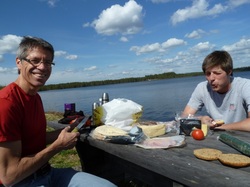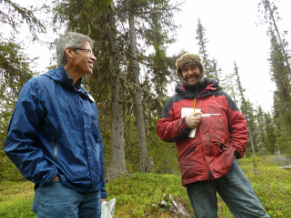There has been a small change in project management over the last few months. Dr. María Arróniz-Crespo has taken over for Lorna Street as the project manager. Although we were extremely sad to see Lorna go to Sheffield to take up a new project, we are extremely pleased to have Maria join us. Maria brings a wealth of bryophyte physiology expertise to our group and also brings a great deal of enthusiasm to the project.

In late May and early June of this year, Maria and I returned to the field sites in Northern Sweden to orient her to the project and to continue running ongoing experiments. During this visit, the weather was extremely warm and sunny, not particularly seasonal for early June at 66o N! We made a number of interesting observations during this time. My oldest son, Emil DeLuca, a junior in Chemistry at the University of Montana, joined us a volunteer field assistant. Emil greatly increased our capacity to collect samples and set up apparatus along the chornosequence. His background in chemistry was also handy when it came time for sample analyses. The Nick Ostle group overlapped with us for a few days and continued to conduct trace gas measurements at the chronosequence sites.

During our stay, we set out a new study on N recycling in the moss canopy using ionic resins, continued work on the chronosequence in terms of N dynamics, collected the final results on a micronutrient experiment and initiated and perhaps completed a study on colonization of feather mosses by proximity to N2 fixing lichen and crusts. There appeared to be little or no relationship between proximity of mosses to crusts and lichen in terms of cyanobacterial colonization or nitrogenase activity. The micronutrient experiment, now in its third year, demonstrated no significant effect of Mo or Fe on N fixation rates with a possible decrease in N2 fixation with Fe addition. Phosphorus stimulated nitrogenase activity in years 1 and 2, but showed little effect in year three (no additional P added). More to report, but there are papers to write!
 RSS Feed
RSS Feed